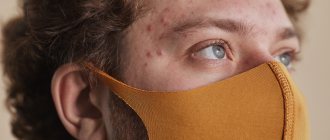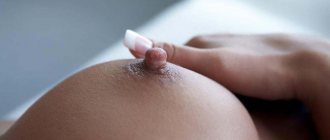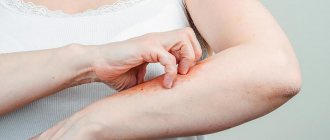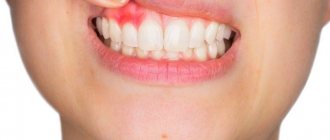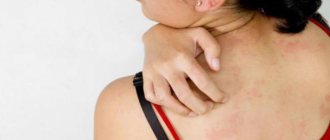Home » Symptoms
Published: November 3, 2018 Category: Symptoms
Often, women notice the appearance of spots on the usually dark areola around the nipple. Uncertainty about the origin of spots on the nipples and areola raises health concerns. However, if white spots appear, they rarely indicate the occurrence of malignant neoplasms.
- 1 What are white spots on nipples
- 2 Causes of white spots on the nipples and areola
- 3 Causes of white pimples on nipples
- 4 White spots in early pregnancy
- 5 White spots on nipples during breastfeeding
- 6 Clogging of pores with colostrum
- 7 Infections 7.1 Thrush
- 7.2 Herpes
- 7.3 Subareolar abscess
Causes of white spots on nipples and areola
A small white dot on the nipple or the appearance of white spots on the dark area around the nipple is caused by a disruption in the production of melanin, the substance responsible for cell pigmentation.
The pigment is produced by special cells - melanocytes, which are destroyed during the autoimmune disease vitiligo. In this case, the body mistakes melanocytes for dangerous cells and destroys them.
Vitiligo affects both women and men. The area of distribution of age spots is not limited to the areola of the nipple, but also affects the area around the lips and fingertips. The spots do not look like even circles, but like a concentration of small white specks.
White spots around the nipples may merge into one large white spot or a smaller spot. Whitening of skin areas is not accompanied by a feeling of pain, but makes the appearance of the diseased person specific due to prominent spots (or stripes) of a different color than the rest of the skin.
White spots in early pregnancy
A short time after pregnancy, women notice the appearance of specific pimples and spots around the nipples. The glands located in these tubercles around the nipples respond to changes in hormonal levels and begin to produce a special oily substance, maintaining the softness and elasticity of the skin of the nipples.
Scientists believe that the substance produced by Montgomery's tubercles attracts breastfed babies. They help him find the nipple when the mother begins to feed the baby for the first time. In addition, the secretion of the glands serves as a lubricant and protects the surface of the nipple and the entrance to the milk ducts from germs.
Changes in the size and number of visible Montgomery tubercles on the nipple are considered one of the earliest indicators of pregnancy. Active secretion production makes the tubercle look like a small bump with a white or yellowish top.
Montgomery's tubercles may enlarge and turn white regardless of pregnancy. The reasons for their manifestation may be:
- Hormonal changes before and during menstruation
- Taking oral contraceptives
- Menopause
- Other changes in hormonal profile
The manifestations of Montgomery tubercles near the nipple are painless and do not require treatment when they occur. However, it is not recommended to pierce the surface or squeeze out the contents of the tubercle due to the risk of infection. Painful sensations in the nipples and redness of the Montgomery tubercles indicate infection inside the glands and serve as a reason for contacting a medical facility.
Montgomery tubercles that do not disappear after childbirth and cessation of breastfeeding can be removed surgically. However, after this procedure, mini-scars will remain on the nipples. The following steps will help reduce the size of nipple bumps:
- Applying a warm, damp towel to the areola every day for 20 minutes (the towel should always be warm).
- The use of creams containing celandine, aloe vera, shea butter or cocoa butter.
- Increasing the amount of water consumed and reducing sugar intake.
- Following a diet will help avoid blockage of the Montgomery glands and their subsequent swelling.
Is treatment required?
Do I need to take any therapeutic measures if my nipples have turned white? The specifics of the therapeutic intervention depend on what exactly provoked the abnormal phenomenon.
If the reason is the presence of some disease in the female body, then the doctor prescribes a treatment regimen that is practiced for this disease:
| State | Features of treatment |
| Thrush | Treatment of thrush is based on an integrated approach. Recommended medications for oral and external use: Miconazole ointment, Candide cream, Nizoral cream, Nystatin ointment, Fluconazole. |
| Additional remedies include: - green tea (suppresses the activity of Candida fungus); - washing the nipples and areolas with a soda solution (1 tsp soda per glass of boiled water); - compresses with vinegar. (add 1 tsp of apple cider vinegar to 100 ml of boiled water. Soak gauze in the solution and apply to the problem area); - exclusion of sweets and foods with yeast from the diet. | |
| Raynaud's syndrome | Therapeutic measures are prescribed (breast massage, air baths, rubbing the skin with oils, etc.). |
| Taking vitamin B6 complex with niacin. Treatment regimen: 100 mg twice daily for several weeks. | |
| Taking Nifedipine. The remedy is prescribed if the methods described above are ineffective. Dosage – 1 tablet per day. The duration of the treatment course is 2 weeks. | |
| Milk stagnation during breastfeeding | In this situation, it is recommended to put the baby to the breast as often as possible so that his chin rests on the area of the plug. Self-massage of the breast is also recommended. If a woman is unable to resolve the problem on her own, she should contact a lactation consultant or mammologist. |
| Vitiligo | Often medications are prescribed that affect the synthesis of melanin and improve metabolic processes in the body, vitamin therapy, and hormonal agents. A good effect is achieved with ultraviolet irradiation, as well as after completing a course of PUVA therapy. |
| Fordyce granules | There are no effective treatments. Basically, the disease disappears on its own by the age of 40. Itchy discomfort can be eliminated through laser correction. |
Additionally, a woman should follow all medical recommendations:
- After feeding, immediately cover your breasts with a warm, damp towel.
- After taking a shower, you should also cover your bust to prevent cold air from entering.
- If a burning sensation is felt, you need to create conditions for an additional flow of blood to the nipple. Olive oil helps a lot in this regard. Take some oily liquid, warm it between your fingers and massage your nipples. This massage significantly reduces pain.
- Dry applications. After feeding, lie down and apply warm heating pads to the areola-nipple area for a few minutes.
- Vitamin therapy.
- Intensive massage of the chest (the area between the collarbone and mammary glands), while the breast itself is not affected.
- Gentle massage of the muscles under the breasts and armpits.
Cosmetic treatment method
In the absence of pathological conditions, when the whitening of the nipples is caused by natural causes, their color can be improved with the help of tattooing.
Cosmetic nipple dyeing is the introduction of a colored pigment under the skin of the areola. The tattoo itself is performed in several stages, using different types of techniques using several pigment substances, thereby achieving their uniform distribution in the tissues of the areolar-nipple area.
Immediately before the procedure itself, the patient receives recommendations about possible contraindications and nipple care in the post-procedure period.
Nipple dyeing technique;
- Anesthesia is performed with a special cream (injections are not practiced in tattooing due to excessive sensitivity of the chest area).
- The introduction of hypoallergenic dyes is carried out with a special device with one or three needles.
- Next, the pigment is shaded or the contour version of the parchment is saved.
- The duration of the correction is approximately an hour.
- The area of the nipples and areola is smeared with cream and covered with cling film for 4-6 hours.
Further care is the same as with other types of tattooing: application of wound-healing agents, antibacterial procedures, avoidance of sunlight on the skin.
The cosmetic effect lasts for an average of 5 years, but experts recommend correction every 2-2.5 years.
Infections
The appearance of pimples is associated with the development of an infection caused by a virus, fungus or bacteria. Although most people are susceptible to infections, breastfeeding women and people with weakened immune systems are at risk.
A white coating on the nipple can also appear on the male chest - the infection can also affect both the skin and the condition of the nipples.
Infections that can cause pimples on the chest:
- Thrush
- Herpes
- Subareolar abscess
Thrush
Thrush is a fungal infection that can develop in the mouth of newborn babies or appear on a woman’s chest as a result of taking antibiotics.
When breastfeeding, the fungus enters the breast tissue through microcracks in the nipple. Symptoms of thrush are the appearance of pimples, accompanied by redness and the development of pain in the nipple-areolar area.
Herpes
The infection is viral in nature. The herpes virus is sexually transmitted, but can be transmitted from mother to child when the woman begins to give birth. The infection affects the infant's oral cavity and is subsequently transmitted to the mother during breastfeeding. Symptoms of herpes include small, fluid-filled blisters on the nipples. Even one punctured blister or burst blister leaves a painful wound, as well as a persistent dark spot on the surface of the areola and nipple.
Subareolar abscess
An abscess is a purulent inflammation of tissue caused by bacterial infection. Most often develops when acute mastitis occurs. Bacteria can also enter the mammary gland from other purulent formations (boils, carbuncles). Such neoplasms are very painful to touch; the skin around the blister is very inflamed, and the body temperature is greatly elevated.
Changing the color of the nipples in pregnant and lactating women
If we said that women are often very scrupulous about their health, then if we talk about pregnant and lactating women, it is worth multiplying this by two, or even three. The female body undergoes incredible changes during pregnancy. During this period, women may wonder: “What color are pregnant nipples?” They look for pictures on the Internet and talk about these topics with “experienced” friends. With the onset of pregnancy, the nipples darken, and sometimes their shade even becomes blue-black. It should be noted that in the third trimester, women note that their nipples turn white. The fact is that during this period colostrum begins to be released, which initially has a transparent consistency, and closer to childbirth it acquires a white tint. Therefore, if your nipples turn white before giving birth, you should know that everything is going as usual.
Painful white spots with lactostasis
Blockage of the milk ducts is accompanied by redness and inflammation of the nipple, as well as an increase in body temperature. This occurs due to stagnation of milk in the mammary gland, manifested by the formation of an inflamed growth with white contents, which begins to hurt more and more.
A woman tries to avoid breastfeeding, but it is not recommended not to breastfeed if lactostasis develops. You can help the ducts free themselves.
To do this you should:
- Apply a warm compress to your breasts before feeding.
- After feeding, apply a cold compress to reduce pain.
- Squeeze a little milk before feeding to soften the nipple.
- During feeding, position the baby so that his lower jaw is near the blocked duct.
If the clogged canal could not be freed from stagnant milk on your own, you should seek help from a specialist. The problem of lactostasis can be solved by puncturing the inflamed, clogged area in the middle of the white spot.
Most types of white plaque around the nipples, as well as the phenomenon of white nipples, occur during lactation and disappear during the implementation of an established feeding pattern. With the adjusted nutritional regimen, the milk ducts are promptly cleared of milk.
Correct positioning of the baby during feeding allows the mother to receive additional stimulation and massage the areola and nipple using the baby's sucking movements.
To prevent the occurrence of lactostasis you should:
- During feeding, make sure that the breast is completely emptied before moving on to the other breast.
- Express excess milk (a special bottle is suitable for storage).
- Monitor the correct position of the baby during feeding.
- Change the baby's position with each new feeding.
- Avoid wearing a tight bra (tightness is indicated by a red stripe on the skin on the side of the chest).
- Position car seat belts, as well as belts of children's portable devices, so that they do not compress the mammary glands of a nursing woman.
Vitamins
Vitamin B6 also has a good effect on such problems.
It is useful for both mother and baby. And yet, the whole complex of B vitamins has the best effect. It is advisable to take it until the pain decreases or even disappears completely. With correctly selected dosages, this complex does not cause side effects. In addition to the fact that the pain goes away, in general the woman becomes more balanced and calm, and her sleep improves. Since vitamins are transmitted through breast milk, a course intake will also be beneficial for the baby. If such a complex does not bring relief a couple of weeks after starting to take it, then it is very likely that B vitamins will not help.
To treat vasospasm, microelements such as magnesium and calcium are also used, and a magnesium preparation is better absorbed by the body in the morning, and a product with calcium is more useful to take at night.
If the above measures do not help, then the woman is prescribed Nifedipine, which is used for hypertension. Take only one tablet (30 mg) per day. The drug relieves pain due to vasospasm. The course of admission is 2 weeks. If pain returns, treatment with this drug should be continued. Before use, you should consult a therapist. This remedy usually does not cause side effects.
Some women with vasospasms use nitroglycerin ointment, which, although it relieves pain, causes severe migraines and has a bad effect on milk.
It's cancer
Despite the fact that the appearance of white dots, spots and pimples usually has nothing to do with malignant neoplasms, in rare cases oncology causes the nipple to turn white. This occurs when the milk duct is compressed by a developing tumor.
In breast cancer, cancer cells form in the tissues of the milk ducts and areola. Their growth, in addition to the appearance of white, inflamed pimples, is accompanied by the following symptoms:
- Redness, swelling, itching
- Peeling or crusting on the surface of the nipple-areolar complex
- “Retracting” the nipple
- Yellow, orange, or bloody nipple discharge
If these manifestations and spots do not go away within 1-2 weeks, you should consult a doctor - a gynecologist or mammologist for advice. A biopsy prescribed in such cases makes it possible to diagnose breast cancer.
Depigmentation
The problem of the appearance of white spots around the nipples as a symptom of vitiligo requires separate consideration.
Vitiligo is a disease of autoimmune origin. In such cases, the causes of the disease are unclear. The following actions will help reduce the consequences of the body’s struggle with its own cells:
- Avoiding stress
- Normalization of the gastrointestinal tract and liver
- Regular massage and other relaxing treatments
- Increasing immunity by taking vitamin complexes and immunomodulators


